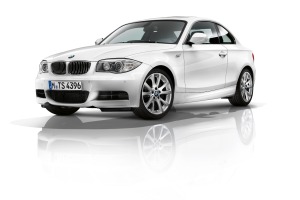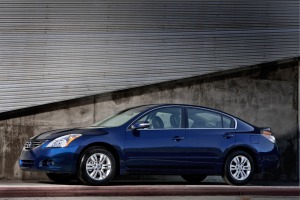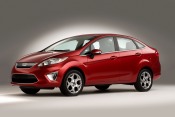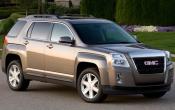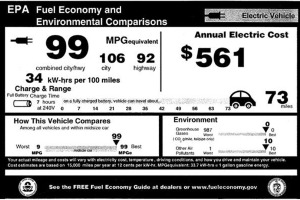
The Nissan Leaf's EPA window sticker touts "99 miles per gallon" in large font. Since the Leaf is a fully electric car and does not burn gasoline, this might seem odd. But look more closely and you'll see the Leaf's "99" is actually an mpg-equivalent (mpg-e) figure, which is the Environmental Protection Agency's (EPA) way of converting the power used by an electric vehicle (EV) into a term familiar to most Americans. This 99 mpg-e number is ultimately more useful for comparing energy consumption than fuel costs, but we'll decode the EPA's electric-car mpg stats and explain what it means to you and your pocketbook.
The final design of the EPA's new EV mpg sticker has yet to materialize for 2012 models, but there will be four key elements to look for with electric vehicles: kilowatt-hours per 100 miles (kWh/100m); mpg-equivalent (mpg-e); annual electric cost; and cruising range. We'll tackle each below.
Efficiency Rating
According to the EPA, when the 2011 Nissan Leaf is driven on its combined (city/highway) mpg cycle, it requires 34 kilowatt-hours of electricity to travel 100 miles (34 kWh/100m). Similar to miles per gallon (mpg), kWh/100m is a measure of the Leaf's efficiency and the most important operating-cost figure for EV owners. Unlike mpg, the lower the kWh/100m number, the better. Adapting to this smaller-is-better figure is likely the roughest math most of us will face in relation to EVs.
The calculation of energy unit per miles (instead of miles per unit of energy) is common in Europe, expressed via the metric system as liters per 100 kilometers. Americans, however, do not generally measure fuel efficiency with this 100-unit yardstick. There are plenty of online tools to convert mpg to gallons per 100 miles (g/100m), and two easy-to-grasp examples of the logic of this measure can be seen by comparing the Toyota Prius and Bugatti Veyron.
With an EPA combined fuel-efficiency rating of 50 mpg, the Prius burns 2 gallons to travel 100 miles (2 g/100m).The thirstier Bugatti's 10-mpg rating means it takes 10 gallons to travel the same distance (10 g/100m). When converted from mpg to g/100 miles, you can see how the Prius' lower figure of 2 g/100m denotes better fuel efficiency than the Bugatti's 10 g/100m. Go electric, and you'll also see how 34 kWh/100m represents better fuel economy than 38 kWh/100m.
Kilowatt-Hours to MPG-Equivalent
So how does the EPA get from 34 kWh/100m to 99 mpg-e? To create the mpg equivalent, the EPA uses an established energy standard of 115,000 BTUs (British thermal units) per gallon of gasoline. Grossly oversimplified: If you ignited 1 U.S. gallon of unleaded gasoline, it would generate that much heat. To create the same amount of heat, you would need 33.7 kilowatt-hours of electricity.
So if the Nissan Leaf could travel 100 miles on 33.7 kWh of electricity (the energy equivalent of 1 gallon of gasoline), it would receive an mpg equivalency of 100 mpg-e. Since the Nissan Leaf requires slightly more than the 33.7 kWh gallon-of-gas equivalent to travel 100 miles (in this case, 34 kWh), it received an mpg equivalency rating of 99 mpg-e. What does all this have to do with fuel economy? Not much.
The mpg-e rating is really only useful for comparing the relative energy consumption of gasoline (or hybrid) cars with that of electric cars. The Leaf uses the energy equivalent of 1 gallon of gasoline for each 99 miles of travel, compared to a hybrid Prius, which would use roughly 2 gallons of gasoline for every 99 miles it travels. Far more pertinent for electric car owners focused on cost is the kilowatt-hours-per-100-miles rating (kWh/100m), which shows you how efficient the vehicle is at converting electricity into miles traveled. The kWh/100m rating is the new EV mpg, and from a pocketbook standpoint, lower is better.
Annual Fuel Cost
An EV's EPA sticker will also list an annual electric cost figure ($561 for the Leaf). Some highly recommended reading will show you that the cost of electricity (and thus EV fill-ups) varies significantly around the U.S. For yearly electric cost, the EPA uses a national average of 11 cents per kWh and an annual driving average of 15,000 miles. If the Leaf will travel 1 mile on 0.34 kWh (34 kWh/100m), multiply 0.34 kWh by 15,000 and you've got 5,100 kWh. At 11 cents per kilowatt-hour, this equals $561.
Also note that though the efficiency rating of the Nissan Leaf is 34 kWh/100m, this doesn't mean it will travel 100 miles on a full charge, only that it would take that much power to go that far. This brings us to cruising range.
Range Rating
An estimated driving-range number also will be part of the new EPA sticker for EVs. In the case of the Leaf, this is about 73 miles on a full charge. Much like mpg, EV range can vary widely depending on how you drive. EVs tend to do better in stop-and-go driving, where regenerative braking can help contribute to battery life, so the Leaf receives a higher mpg-e rating for city (106) than highway (92). For the EPA range test, EVs are driven continuously on the combined cycle until the wheels stop.
As with gasoline, your mileage per kilowatt may vary, depending on how much of a leadfoot you are. Regardless of what the final version of the upcoming EPA sticker looks like, the number you want to focus on is the kilowatt-hours per 100 miles (kWh/100m). Start wrapping your head around a new fuel economy measure where smaller is better.






